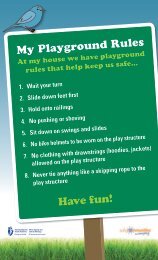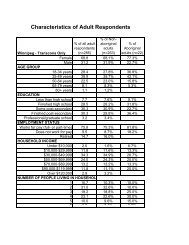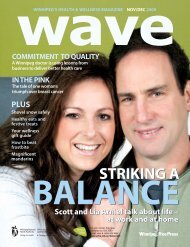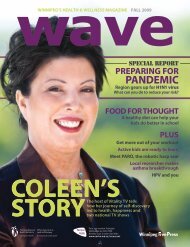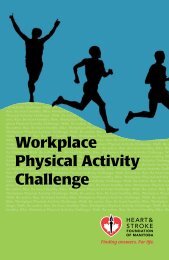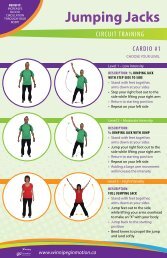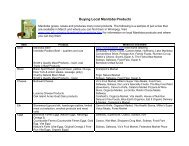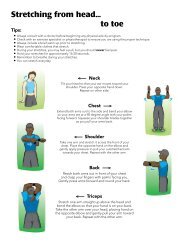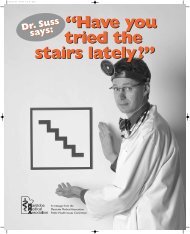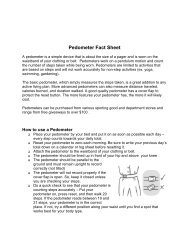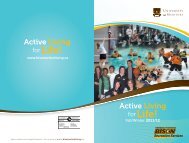Wave: March / April 2010 - Winnipeg in motion
Wave: March / April 2010 - Winnipeg in motion
Wave: March / April 2010 - Winnipeg in motion
Create successful ePaper yourself
Turn your PDF publications into a flip-book with our unique Google optimized e-Paper software.
Th<strong>in</strong>k<br />
Safety<br />
Concordia Hospital health-care aide Darlene<br />
Payette <strong>in</strong>jured herself on the job. Now she<br />
wants to make sure other health-care providers<br />
learn from her experience.<br />
By Susie Strachan<br />
Darlene Payette always tried to be careful when<br />
lift<strong>in</strong>g a patient <strong>in</strong>to a wheelchair.<br />
Then one day the health-care aide at<br />
Concordia Hospital was com<strong>in</strong>g to the end<br />
of a double-shift when a patient required<br />
a lift. Darlene was transferr<strong>in</strong>g the patient<br />
with another staff member when the patient<br />
shifted. Suddenly, Darlene felt a sharp<br />
pa<strong>in</strong> <strong>in</strong> her back.<br />
Unfortunately, <strong>in</strong>jury on the job is not an<br />
uncommon occurrence among health-care<br />
providers. Every year, as many as 4,500<br />
workers <strong>in</strong>jure themselves, often by lift<strong>in</strong>g<br />
patients, mov<strong>in</strong>g them <strong>in</strong> bed or assum<strong>in</strong>g<br />
awkward postures when provid<strong>in</strong>g care.<br />
Now, the <strong>W<strong>in</strong>nipeg</strong> Health Region is<br />
work<strong>in</strong>g with the Workers Compensation<br />
Board and Manitoba Health through<br />
the SAFE Health Care program to raise<br />
awareness and help reduce the number of<br />
<strong>in</strong>juries on the job.<br />
Payette says it’s important for health-care<br />
workers to learn from her experience. She<br />
says all health-care workers should know<br />
their rights and responsibilities when it<br />
comes to on-the-job safety.<br />
It often comes down to many situations<br />
<strong>in</strong> which one tries to do too much<br />
without help. “I often was work<strong>in</strong>g two or<br />
three shifts <strong>in</strong> a row. I might have to look<br />
26 WAVE<br />
after seven patients by myself and five of<br />
those needed lifts. I knew these patients<br />
all needed more assistance to move them<br />
safely, but there wasn’t always someone<br />
around to help,” says Payette, who works<br />
<strong>in</strong> the subacute medical ward at Concordia,<br />
which often cares for frail, geriatric<br />
patients. “You get <strong>in</strong>to a position where you<br />
go ahead and try the transfer without help<br />
or the proper equipment.<br />
Not only does this put the patient <strong>in</strong><br />
danger of be<strong>in</strong>g hurt, it’s a bad practice that<br />
puts the worker <strong>in</strong> danger of be<strong>in</strong>g <strong>in</strong>jured.<br />
Spra<strong>in</strong>ed wrists, twisted and stra<strong>in</strong>ed back<br />
muscles, and sore necks and shoulders<br />
are some of the <strong>in</strong>juries that health-care<br />
aides encounter when they try to get ahead<br />
of their workload. “Many people th<strong>in</strong>k<br />
they’ll get their work done faster. But we’re<br />
deal<strong>in</strong>g with patients, who may need two<br />
people lift<strong>in</strong>g them,” says Payette. “I’ve<br />
caught people do<strong>in</strong>g a two-person lift,<br />
one that called for them to use either the<br />
Sl<strong>in</strong>g Lift or the Sit-Stand Lift mach<strong>in</strong>e, by<br />
themselves without equipment, just to save<br />
a few moments. That’s a very unsafe way to<br />
do a transfer.”<br />
Payette says health-care providers need<br />
to slow down and follow the rules. Each<br />
patient’s chart should have a logo on it,<br />
which describes how the lifts should be<br />
done and what equipment should be used.<br />
This logo is the result of an assessment<br />
done by a physiotherapist and nurs<strong>in</strong>g staff.<br />
Health-care workers should not proceed<br />
with a transfer if they are unsure how to<br />
do it or do not have the right tools. They<br />
need to be empowered to stop and make<br />
sure they have all the proper <strong>in</strong>formation,<br />
equipment and support to do the transfer<br />
safely. Sadly, some health-care aides fail<br />
to recognize their rights and duties <strong>in</strong> this<br />
matter.<br />
Another area of oversight occurs when<br />
a health-care aide does get <strong>in</strong>jured. Many<br />
ignore the <strong>in</strong>jury, and hope that putt<strong>in</strong>g ice<br />
on the sore spot will help. Payette says the<br />
fear of the paperwork <strong>in</strong>volved <strong>in</strong> report<strong>in</strong>g<br />
the <strong>in</strong>jury is an obstacle for many. But it<br />
is important to complete the <strong>in</strong>jury report<br />
immediately after <strong>in</strong>jury to ensure the <strong>in</strong>jured<br />
worker has access to benefits such as<br />
physiotherapy and salary coverage by the<br />
Workers Compensation Board.<br />
The SAFE Health Care program is designed<br />
to help health-care workers protect



